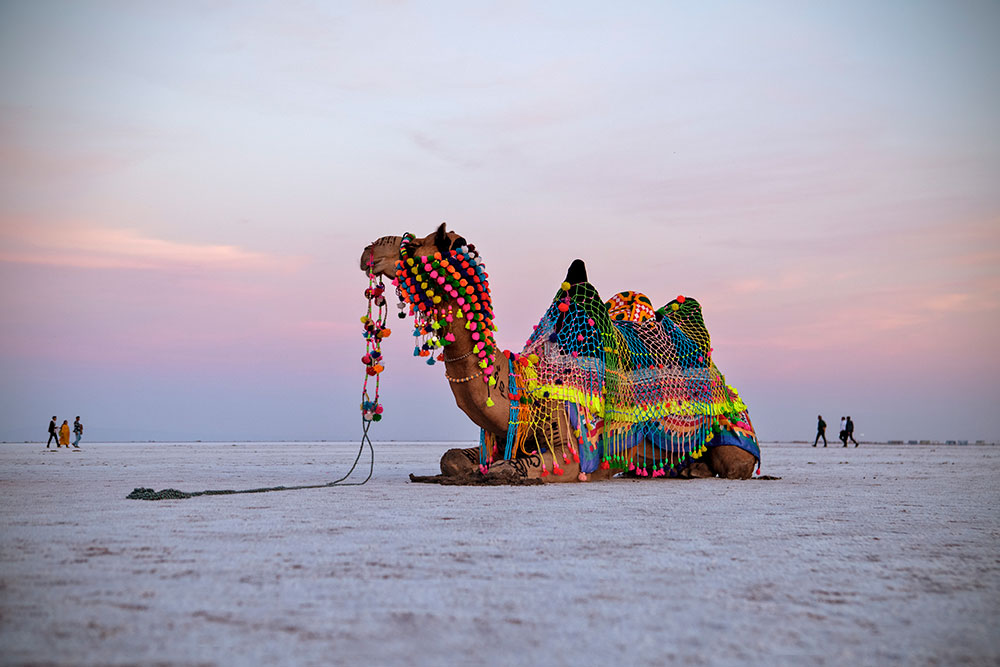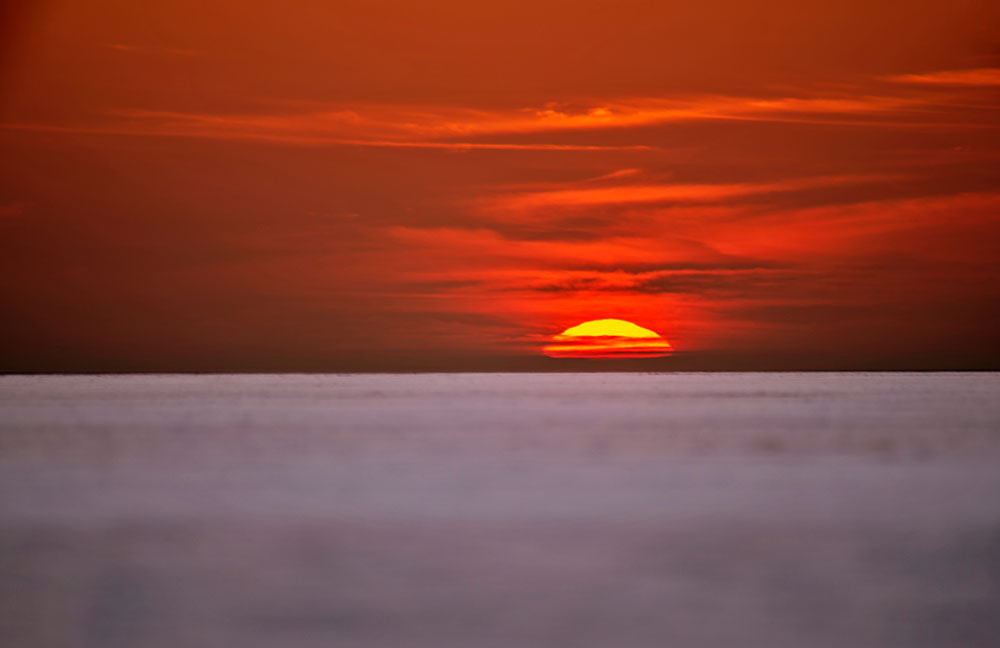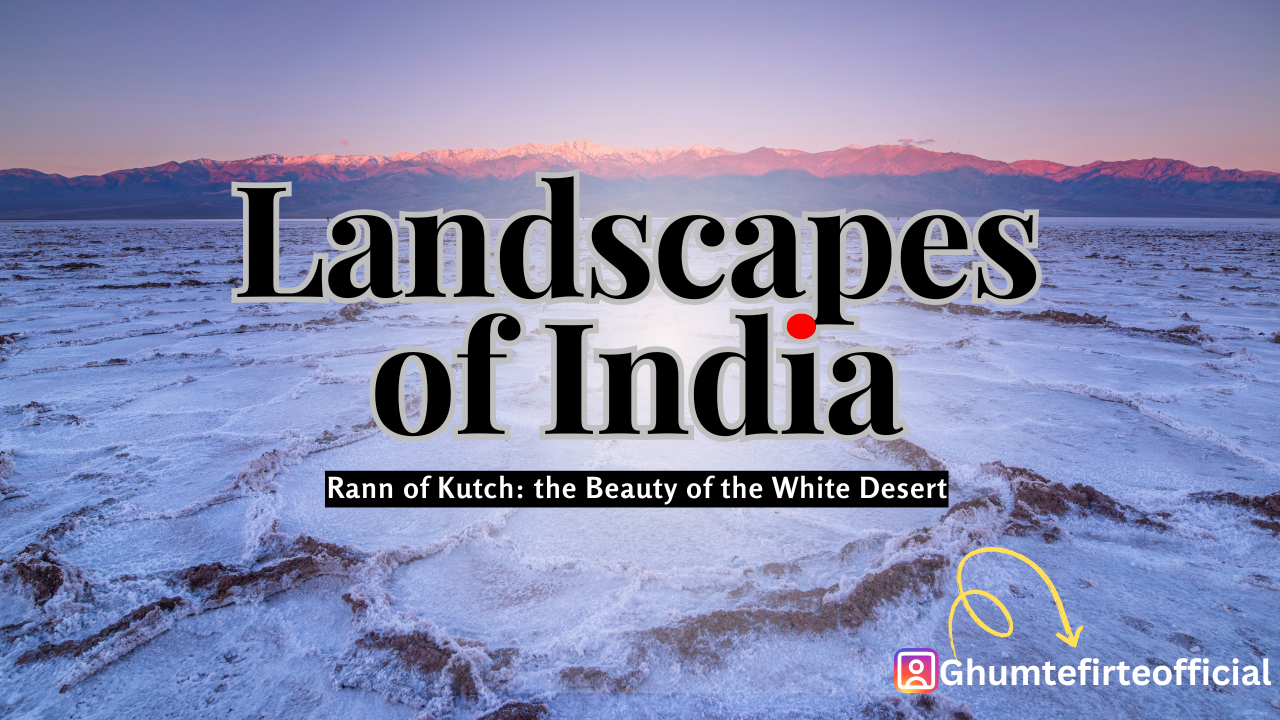The Rann of Kutch, in Gujarat, India, is one of the world’s biggest salt deserts. It is a one-of-a-kind environment that changes radically with the seasons and covers more than 30,000 square kilometers. The Rann is a location of extraordinary beauty and cultural depth, ranging from a large, parched salt marsh in the summer to a gleaming white wonderland in the winter.
Table of Contents
About The Rann of Kutch:
1. Geography and Landscape:
The Rann of Kutch divides into two parts, The Great Rann is a huge white salt desert.
The Little Rann is known for its animal refuge and salt pans. Located between Gujarat’s Kutch District and Pakistan’s Sindh Province. It is located slightly above the Tropic of Cancer, bordered by the Thar Desert on one side and the Arabian Sea on the other.
2. Special characteristics:
White Salt Desert: The evaporation of saltwater created a wide expanse of white salt.
During monsoons, the Rann is buried in water, creating a large swamp.
In the winter, the water evaporates, exposing the sparkling white salt surface
3. Biodiversity and Ecology:
The Indian Wild Ass, which cannot be found anywhere else in the world, lives at the Wild Ass Sanctuary in the Little Rann.
During the winter, there is a diverse bird population, including flamingos, pelicans, and migrating species.
Suaeda and salt-tolerant grasses are examples of vegetation that are uniquely suited to saline soil.
4. The cultural Significance:
The region’s traditional handicrafts include Bandhani fabrics, Ajrakh patterns, and delicate needlework created by local artists.
Local tribes, like the Kutchi, Rabari, and Ahir, are noted for their lively culture and friendliness.5. Rann Utsav.
A colorful cultural event held from November to February.
Highlights include traditional musical and dance performances.
Camel rides, hot air ballooning, and outdoor activities.
Luxury tent lodgings provide an immersive experience.
The best time to visit is on full moon evenings, when the white desert sparkles ethereally.


Nearby Places In Rann Of Kutch:
1. Rann Utsav Tent City:
A Wonderful Stay in the White Desert. The Rann Utsav Tent City is a particularly designed lodging site set up each year in the Great Rann of Kutch for the Rann Utsav, a cultural event held from November to February. This large tent city allows tourists to remain near to the stunning white salt desert while also experiencing Kutch’s colorful cultural events.
1. Accommodation Options
The Tent City has about 400 tents divided into several levels of luxury:
Premium Tents are luxurious lodgings with air conditioning and soft furniture.
Deluxe Tents: Comfortable tents equipped with basic amenities and air conditioning.
Standard Tents: Cost-effective choices with basic amenities. Click To Get Here
2. Facilities
En-suite bathrooms with hot and cold water.
Electricity is available 24/7, and the beds are comfy.
Recreational areas include eating places, cultural zones, and activity centers.
3. Cultural Immersion
Guests can enjoy traditional folk music and dance performances.
Handicraft shows including Kutchi needlework, Bandhani, and ceramics.
Local cuisine is provided in specially equipped dining tents.The Rann Utsav Tent City is more than simply a place to stay; it’s a complete experience that combines comfort, adventure, and cultural immersion. Whether it’s the breathtaking majesty of the salt desert or the vivid energy of Kutchi customs, a stay in the Tent City guarantees unique experiences.
2. Road to Heaven:
The Beautiful Drive to Rann of Kutch.
The trek to Rann of Kutch, sometimes known as the “Road to Heaven,” is a magnificent experience. The stretch leading to the white salt desert provides a bizarre scene that feels otherworldly, especially in the winter. Route and Scenic Beauty 1. The Approach
As you leave Bhuj, the nearest city to the Rann, the scenery begins to change.
The desolate, desert-like landscapes contrast sharply with the glistening salt flats that meet you closer to the goal.
2. The Final Stretch.
The route to White Rann is flat and straight, bordered by large, uninhabited stretches of countryside.
During the winter, the salt desert’s whiteness reflects sunlight, producing an otherworldly radiance.
At sunset, the skies are painted in orange, crimson, and purple, adding to the beautiful atmosphere.
3. Full Moon Magic.
The route becomes even more enchanting on the full moon evenings, when the white desert glows under the moonlight, creating the appearance of a shimmering trail to Paradi.
Key Features of the Drive:
Smooth roads:
Well-kept highways and local roads guarantee a pleasant drive.
The most common route goes through Bhuj, which is accessible by air, train, and road. Scenic stops:
Kala Dungar (Black Hill) is the highest peak in Kutch, with panoramic views of the Rann.
India Bridge: A military checkpoint that marks the final civilian-accessible location before the Rann.
Cultural Encounters Villages like Hodka and Dhordo highlight Kutchi art, architecture, and traditions.
3. Vijay Vilas Palace: A Royal Gem in Mandvi:
The Vijay Vilas Palace in Mandvi, Gujarat, is a breathtaking architectural masterpiece that captures the luxury and majesty of royal tradition. Built in 1929 by Kingdom The Yuvraj Shri Vijayaraji. the palace served as a summer retreat for the rulers of Kutch and remains a symbol of their regal lifestyle.
Architecture & Design:
The palace combines Rajput, Victorian, and Mughal architectural styles, including domes, jharokhas (balconies), and elaborate stone carvings.
It is built of red sandstone, which lends a timeless quality to its imposing construction.
The key features include:
The Central Dome offers panoramic views of the surrounding region.
Beautiful Arches and Pillars: Showcases amazing craftsmanship.
Lush gardens surround the castle and are filled with fountains and marble walks.
Cultural Significance:
The palace has been a popular location for Bollywood films, most notably “Hum Dil De Chuke Sanam” and others.
It symbolizes the Jadeja dynasty’s rich cultural and historical history in Kutch.
Tourist Highlights:
1. Royal Interiors.
The rooms are decorated with ancient furniture, royal paintings, and antiques, providing an insight into the royal family’s lavish lifestyle.
The palace also includes an armory, which displays antique weaponry.
2. Rooftop views
The rooftop offers stunning views of the Arabian Sea, beautiful flora, and the vast Mandvi beach.
3. Private beach.
The royal estate has a private beach and peaceful surroundings, giving it an exclusive and relaxing hideaway.
4. Sunset views.
The palace is a famous site to see the breathtaking sunsets over the Arabian Sea.
4. 72 Jinalaya Jain Temple:
The 72 Jinalaya Jain Temple, also known as the Bauter Jinalaya, is a prominent Jain temple complex in Gujarat’s Kutch area, near Mandvi. This hallowed location is devoted to Tirthankaras, Jainism’s spiritual masters, and is a must-see for its peaceful environment, architectural beauty, and spiritual importance.
Key Features of the Temple:
1. Architectural splendor.
The temple is constructed in a typical Jain architectural style, with beautifully carved domes, pillars, and arches.
The main temple complex has 72 tiny shrines, each with a figure of a Jain Tirthankara, representing Jainism’s vast spiritual history.
2. Spiritual significance.
The number 72 has a holy value in Jainism, signifying the 24 Tirthankaras from the past, present, and future throughout three time cycles.
The temple is a place of meditation, introspection, and devotion for Jain pilgrims.
3. Peaceful surroundings.
The temple, set in a quiet area, provides a serene and relaxing environment suited for spiritual searchers.
The 72 Jinalaya Jain Temple is more than a place of worship; it is also a spiritual retreat and a work of Jain art and architecture. Its tranquil surroundings and beautiful craftsmanship make it a must-see for visitors seeking tranquility, devotion, or an understanding of India’s rich religious tradition.
5. Mandvi Beach is a beautiful retreat in Kutch:
Mandvi Beach, in Gujarat’s Kutch area, is a scenic and quiet resort on the Arabian Sea coast. The beach, with its golden beaches, tranquil waves, and easygoing environment, is an ideal retreat for people seeking quiet and natural beauty.
Attractions of Mandvi Beach.
1. Scenic Beauty
The beach has silky golden beaches flanked by luxuriant palm trees, providing a lovely environment.
It offers amazing sunset views, making it a favorite photographic location.
2. Camel and Horse Rides.
Visitors may take camel and horse rides down the beach, bringing a unique twist to the beach experience.
3. Adventure Activities.
Adventurers can participate in activities such as parasailing, jet skiing, and ATV rides.
4. Calm waters.
The shallow and quiet waters make it a safe and delightful place to swim and paddle.
How to Reach the Rann of Kutch
Nearest Hub: Bhuj.
Bhuj serves as the primary entry point to the Rann of Kutch. Most travelers start their journey here.
The nearest airport to the White Rann is Bhuj, located around 80 kilometers away.
Bhuj is well-connected to major cities such as Mumbai, Ahmedabad, and Delhi by regular airline.
The nearest train station is Bhuj Railway Station, located around 70 kilometers from the Rann.
Trains link Bhuj to cities like as Ahmedabad, Mumbai, and Delhi.
Bhuj is connected to various cities in Gujarat via well-maintained roadways.
The distance from Ahmedabad to Bhuj is around 330 kilometers (7 hours by car).
State and private buses travel frequently between Bhuj and other important cities in Gujarat.
From Bhuj to Rann of Kutch.
1. By Private Vehicle.
The quickest and most flexible method to get to the Rann is to take a cab or hire a car from Bhuj.
Dhordo, the settlement that serves as the White Desert’s major access point, is a 90-minute journey away.
2. By Public Transportation.
Buses connect Bhuj and surrounding communities such as Dhordo, however their regularity may be restricted. Taxis and shared jeeps are also available for hiring in Bhuj.
Permits for White Rann
Visitors must get a permit to access the White Rann, which is located near the India-Pakistan border.
Permits may be purchased online or at the BSF Check Post in Bhirandiyara, the way to Dhordo.
Documents needed:
A government-issued ID (such as an Aadhar card or passport).
International travelers should bring copies of their passports and visas.
Climate in The Rann of Kutch:
A Mix of Extremes
The Kutch area of Gujarat, home to the famed Rann of Kutch, has an arid to semi-arid climate. The weather of Kutch is divided into seasons, with scorching summers, short monsoons, and chilly winters.
1. Summers (March–June)
Daytime temperatures range from 35°C to 45°C
The nights are slightly cooler, although still warm.
Summers are hot and dry, with significant evaporation rates.
Dust storms are widespread owing to high winds and dry weather.
Impact: High temperatures make visiting unsuitable.
2. Monsoons (July-September)
Temperatures drop somewhat, from 25°C to 35°C.
The region has low to moderate rainfall, with an annual average of 330 mm (13 inches).
The Rann of Kutch is inundated, resulting in a marshy environment.
Weather: Humidity rises, but remains bearable.
Impact: Rainfall provides respite, but waterlogging in the salt desert can make navigation problematic.
3. Winters (October–February)
Daytime temperatures are comfortable, ranging from 12°C to 28°C
Nighttime temperatures can decrease between 7°C to 10°C
Winters are chilly and dry, with bright sky and little rain.
This is the ideal time to visit Kutch, especially during the Rann Utsav.
Kutch faces climatic challenges include aridity and limited rainfall, leading to water scarcity.
Extreme Temperatures: Summers are brutal, and winters may be surprisingly frigid at night.
Flooding in the Monsoons: During the monsoons, the Rann changes into a swamp, making certain sections inaccessible.
Read Our Latest Blog Hampi, A Timeless Treasure of Indian Heritage
To Know More Place visit Ghumtefirte

